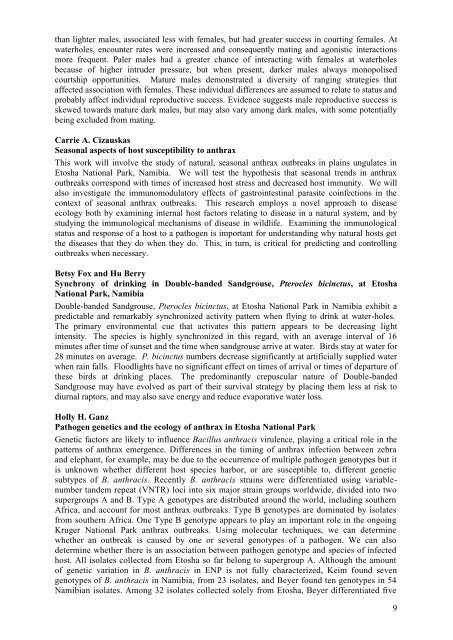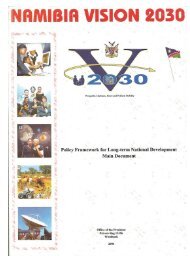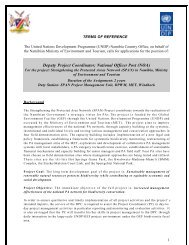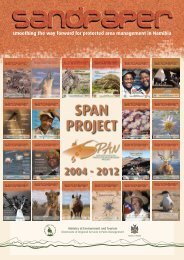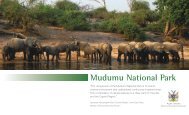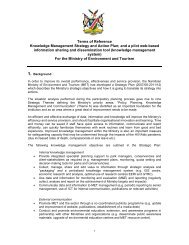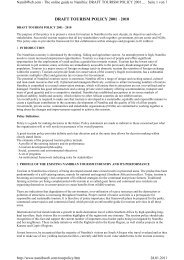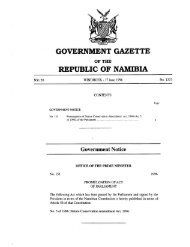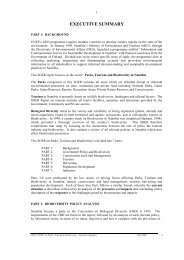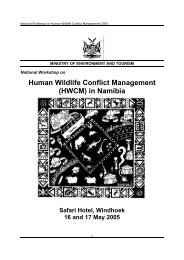Etosha: the Human Footprint - Ministry of Environment and Tourism
Etosha: the Human Footprint - Ministry of Environment and Tourism
Etosha: the Human Footprint - Ministry of Environment and Tourism
Create successful ePaper yourself
Turn your PDF publications into a flip-book with our unique Google optimized e-Paper software.
than lighter males, associated less with females, but had greater success in courting females. At<br />
waterholes, encounter rates were increased <strong>and</strong> consequently mating <strong>and</strong> agonistic interactions<br />
more frequent. Paler males had a greater chance <strong>of</strong> interacting with females at waterholes<br />
because <strong>of</strong> higher intruder pressure, but when present, darker males always monopolised<br />
courtship opportunities. Mature males demonstrated a diversity <strong>of</strong> ranging strategies that<br />
affected association with females. These individual differences are assumed to relate to status <strong>and</strong><br />
probably affect individual reproductive success. Evidence suggests male reproductive success is<br />
skewed towards mature dark males, but may also vary among dark males, with some potentially<br />
being excluded from mating.<br />
Carrie A. Cizauskas<br />
Seasonal aspects <strong>of</strong> host susceptibility to anthrax<br />
This work will involve <strong>the</strong> study <strong>of</strong> natural, seasonal anthrax outbreaks in plains ungulates in<br />
<strong>Etosha</strong> National Park, Namibia. We will test <strong>the</strong> hypo<strong>the</strong>sis that seasonal trends in anthrax<br />
outbreaks correspond with times <strong>of</strong> increased host stress <strong>and</strong> decreased host immunity. We will<br />
also investigate <strong>the</strong> immunomodulatory effects <strong>of</strong> gastrointestinal parasite coinfections in <strong>the</strong><br />
context <strong>of</strong> seasonal anthrax outbreaks. This research employs a novel approach to disease<br />
ecology both by examining internal host factors relating to disease in a natural system, <strong>and</strong> by<br />
studying <strong>the</strong> immunological mechanisms <strong>of</strong> disease in wildlife. Examining <strong>the</strong> immunological<br />
status <strong>and</strong> response <strong>of</strong> a host to a pathogen is important for underst<strong>and</strong>ing why natural hosts get<br />
<strong>the</strong> diseases that <strong>the</strong>y do when <strong>the</strong>y do. This, in turn, is critical for predicting <strong>and</strong> controlling<br />
outbreaks when necessary.<br />
Betsy Fox <strong>and</strong> Hu Berry<br />
Synchrony <strong>of</strong> drinking in Double-b<strong>and</strong>ed S<strong>and</strong>grouse, Pterocles bicinctus, at <strong>Etosha</strong><br />
National Park, Namibia<br />
Double-b<strong>and</strong>ed S<strong>and</strong>grouse, Pterocles bicinctus, at <strong>Etosha</strong> National Park in Namibia exhibit a<br />
predictable <strong>and</strong> remarkably synchronized activity pattern when flying to drink at water-holes.<br />
The primary environmental cue that activates this pattern appears to be decreasing light<br />
intensity. The species is highly synchronized in this regard, with an average interval <strong>of</strong> 16<br />
minutes after time <strong>of</strong> sunset <strong>and</strong> <strong>the</strong> time when s<strong>and</strong>grouse arrive at water. Birds stay at water for<br />
28 minutes on average. P. bicinctus numbers decrease significantly at artificially supplied water<br />
when rain falls. Floodlights have no significant effect on times <strong>of</strong> arrival or times <strong>of</strong> departure <strong>of</strong><br />
<strong>the</strong>se birds at drinking places. The predominantly crepuscular nature <strong>of</strong> Double-b<strong>and</strong>ed<br />
S<strong>and</strong>grouse may have evolved as part <strong>of</strong> <strong>the</strong>ir survival strategy by placing <strong>the</strong>m less at risk to<br />
diurnal raptors, <strong>and</strong> may also save energy <strong>and</strong> reduce evaporative water loss.<br />
Holly H. Ganz<br />
Pathogen genetics <strong>and</strong> <strong>the</strong> ecology <strong>of</strong> anthrax in <strong>Etosha</strong> National Park<br />
Genetic factors are likely to influence Bacillus anthracis virulence, playing a critical role in <strong>the</strong><br />
patterns <strong>of</strong> anthrax emergence. Differences in <strong>the</strong> timing <strong>of</strong> anthrax infection between zebra<br />
<strong>and</strong> elephant, for example, may be due to <strong>the</strong> occurrence <strong>of</strong> multiple pathogen genotypes but it<br />
is unknown whe<strong>the</strong>r different host species harbor, or are susceptible to, different genetic<br />
subtypes <strong>of</strong> B. anthracis. Recently B. anthracis strains were differentiated using variablenumber<br />
t<strong>and</strong>em repeat (VNTR) loci into six major strain groups worldwide, divided into two<br />
supergroups A <strong>and</strong> B. Type A genotypes are distributed around <strong>the</strong> world, including sou<strong>the</strong>rn<br />
Africa, <strong>and</strong> account for most anthrax outbreaks. Type B genotypes are dominated by isolates<br />
from sou<strong>the</strong>rn Africa. One Type B genotype appears to play an important role in <strong>the</strong> ongoing<br />
Kruger National Park anthrax outbreaks. Using molecular techniques, we can determine<br />
whe<strong>the</strong>r an outbreak is caused by one or several genotypes <strong>of</strong> a pathogen. We can also<br />
determine whe<strong>the</strong>r <strong>the</strong>re is an association between pathogen genotype <strong>and</strong> species <strong>of</strong> infected<br />
host. All isolates collected from <strong>Etosha</strong> so far belong to supergroup A. Although <strong>the</strong> amount<br />
<strong>of</strong> genetic variation in B. anthracis in ENP is not fully characterized, Keim found seven<br />
genotypes <strong>of</strong> B. anthracis in Namibia, from 23 isolates, <strong>and</strong> Beyer found ten genotypes in 54<br />
Namibian isolates. Among 32 isolates collected solely from <strong>Etosha</strong>, Beyer differentiated five<br />
9


